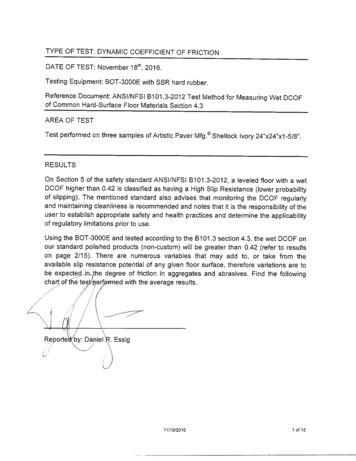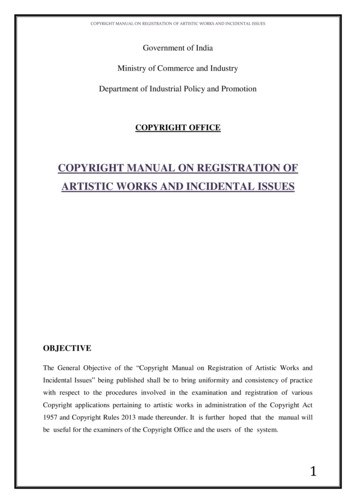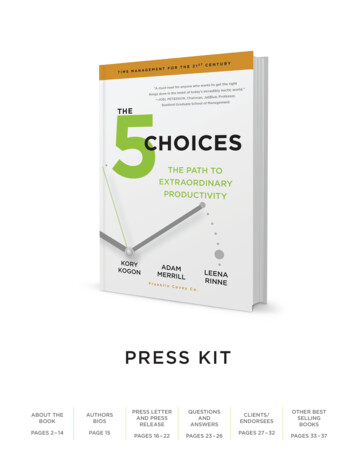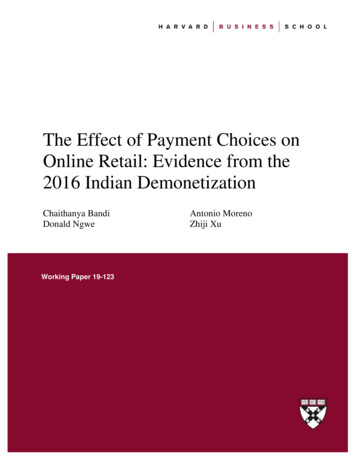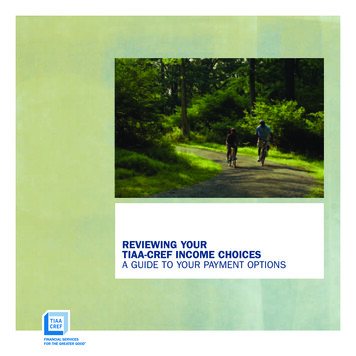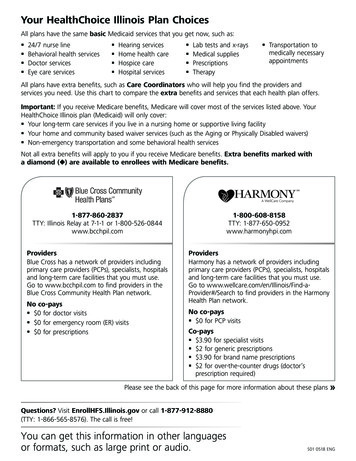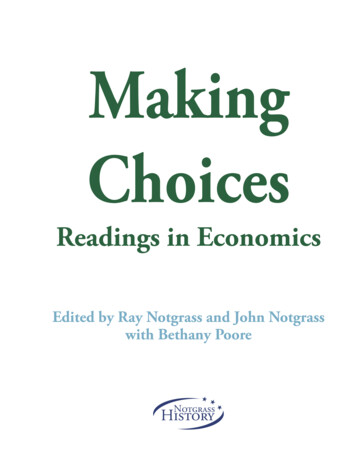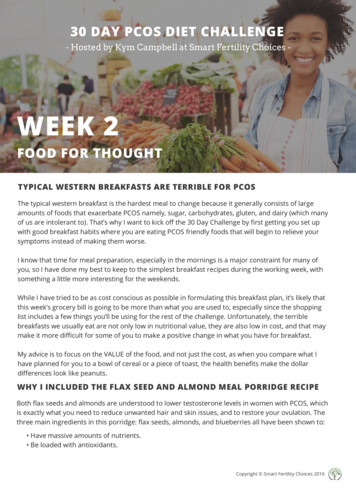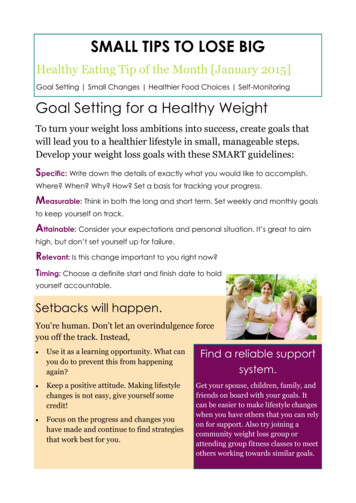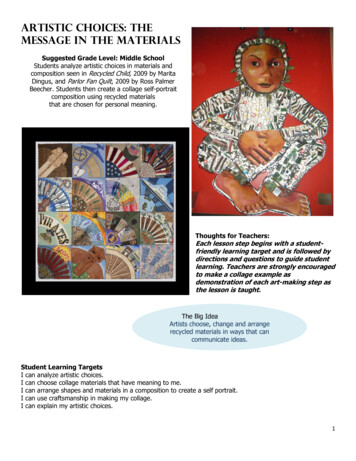
Transcription
ARTISTIC CHOICES: TheMessage in the MATERIALSSuggested Grade Level: Middle SchoolStudents analyze artistic choices in materials andcomposition seen in Recycled Child, 2009 by MaritaDingus, and Parlor Fan Quilt, 2009 by Ross PalmerBeecher. Students then create a collage self-portraitcomposition using recycled materialsthat are chosen for personal meaning.Thoughts for Teachers:Each lesson step begins with a studentfriendly learning target and is followed bydirections and questions to guide studentlearning. Teachers are strongly encouragedto make a collage example asdemonstration of each art-making step asthe lesson is taught.The Big IdeaArtists choose, change and arrangerecycled materials in ways that cancommunicate ideas.Student Learning TargetsI can analyze artistic choices.I can choose collage materials that have meaning to me.I can arrange shapes and materials in a composition to create a self portrait.I can use craftsmanship in making my collage.I can explain my artistic choices.1
I can analyze artistic choices. Every artist makes many choices in the process of making a work of art. We are going to analyze thechoices artists made in creating two works of art by describing what we see: what materials, shapes,textures and colors the artist used, and how they are arranged in a composition. Look closely at Recycled Child, by Marita Dingus. (student worksheet provided)Make a list of what you see: lines, colors, shapes, textures, and things you recognize.How did the artist arrange or organize the parts of the picture or composition?Do you see something that might be found or recycled? What do you think it is? Recycled Child is a mixed media assemblage: It was created for Seattle Central Community Collegeand is a combination of hand-painted elements and found materials. It is located next to the recyclingprogram at the college. The computer parts that can be seen on the body came from the InformationTechnology department, also located in the building where the art is installed.Artist StatementRecycled Child is a metaphor for the latentpotential inside of ethnic minorities whoare often discarded and undervalued. Look closely at Parlor Fan Quilt, by Ross Palmer Beecher.Make a list of what you see: lines, colors, shapes, textures, things you recognizeHow did the artist arrange or organize the parts of the picture or composition?Do you see something that might be found or recycled? What do you think it is? Think about what you have noticed in the art and how the parts have been arranged: share what youthink the art might be about and why you think so. Parlor Fan Quilt is installed at Pioneer Middle School in Dupont and recognizes community historyand school purpose. It is made from an assortment of materials including oil paint on wood and tin,recycled glass from the school’s garden, soda can flip tops, deerskin, computer keyboard parts,arrowheads, a watering can, and other materials.Artist StatementParlor Fan Quilt is . We will be making artistic choices as we make a collage made out ofrecycled papers (collage means “to paste” in French) that is inspired byboth of these artworks. A collage can be like a quilt since it is made of manyindividual shapes that are pieced together or layered. Assemblages are similarto collages except that they are made of materials that tend to be more threedimensional.VocabularyAcrylic CraftsmanshipDetailLayerMixed ureThree-dimensionalQuilt2
I can choose collage materials that have meaning to me. Create a collage that is a portrait of you. Your self-portrait will be made of shapes, colors,symbols and materials you thoughtfully select because they have meaning to you. They will form thefeatures of your face, parts of a background and/or a border for your composition. The heavier paper is for the background. (If there are color choices, your first artistic choice is thecolor of background). Select materials for your collage that communicate something about you past,present and future Think about your family, history, culture, friends, talents, beliefs, goals, things youlike to do. Find colors, pictures, and symbols that you can clearly connect with who you are. You willbe asked to explain your artistic choices—how the collage materials you choose communicatesomething about you or are meaningful to you.Gathering MaterialsHonor the diversity and uniqueness ofyour students by gathering (or havingthem gather) a broad range of interestingpaper materials. Include publications indiverse languages or images that includecultural symbols.Caution: setting out entire ordinarymagazines can encourage restlessbrowsing and predictable results.Managing MaterialsIn collage, ideas can spark materials choicesand materials choices can spark ideas.Limiting materials and tools to just scissorsand paper pushes students to become morecreative.Set out enticing collage materials on a longcounter or table. Model the artistic selectionprocess, as choices are as important ascutting and gluing. Set an initial time limit for“shopping for materials” to 3-5 materials tostart. Students can return later for differentmaterials.MaterialsHeavy cardstock, file folders, or mat board in colors: 9x12 inches or smallerNewspaper for cutting practice, scissors, acrylic medium, brushes, small containers,glue mats, Optional: mirrors, facial proportion diagramsCollectSkin tone papers, publications, catalogs, stickers, greeting cards, sheet music,advertisements, old books, maps, school worksheets, colorful envelopes, paper bags, 3tickets, stamps, gift wraps, or pre-selected pages from magazines like NationalGeographic and Popular Mechanics
I can arrange shapes and materials in a composition to create a self portrait. Practice cutting out different shapes using newsprint first: cut a precise rectangle and a then a spiral.Hold scissors still, open blades wide and move the paper with your other hand to create detailedshapes. We will be creating details with paper, not by drawing on paper, so precision is important. There are two different ways we will be recycling materials into art. Oneis to find pictures of things that are meaningful to us that we cut outcarefully. An ice cream cone, a basketball, a cat, a mountain, a bicycle wheel ora flower might find it’s way into you collage. The second way is to cut out shapes for our portrait or otherparts of our composition using the collage papers available. You might cutout these shapes from symbolic or special colors, sheet music, printed paper,or interesting textures or patterns. Look at the face in Recycled Child and think about the shapes we see in a face: Ovals, circles, curvyshapes for lips, noses, and eyebrows (Optional: facial proportion can be a concept built into thislesson). Cut out shapes for your face and features. You can layer shape upon shape. Arrange and rearrange your composition. Your face does not need to be in the middle of yourcollage and can overlap other shapes or pictures you have chosen or cut out. Collage lets us movethings around before we commit to a final composition (unlike other art processes). The backgroundarea behind or around your face can be a place, or pictures and shapes can float .You might want tocreate a border. Be thoughtful in organizing your composition.Assessment in Progress: Students arrange major elements of compositions and check in with teacher foralignment with learning targets before gluing.4
I can use craftsmanship in making my collage. Craftsmanship means using care, thought, and skill in making something. It also means that whatyou make will not fall apart. In collage it means that all parts are carefully and smoothly cut out,securely attached to the background with not loose or flapping. When your collage composition has been approved and is ready to be glued down, carefully glue downeach shape. Brush acrylic medium to cover all of the back of each shape, place, and smooth downfully. (This is hard to reverse, so be precise) Brush medium over the top of the whole collage to seal.Do not continue to brush once surface is covered since it makes the medium become cloudy.I can explain my artistic choices. Describe at least five recycled materials or pictures that you used in your collage and explain why theyhave meaning to you.(See worksheet)Lesson Alternatives or ExtensionsStudents alter and arrange recycled materials with personal meaning to create an image of their hand as aportrait of self.Students can create a setting or place that has personal significance using recycled materials with personalmeaningCollages can be created on square paper and arranged like a quilt for display.5
Washington State Arts Learning Standards: Visual ArtAnchor Standard 1: Creating: Generate and conceptualize artistic ideas and work.Performance Standard (VA:Cr1.2.6): a. Formulate an artistic investigation of personally relevant content for creating art.Anchor Standard 2: Creating: Organize and develop artistic ideas and work.Performance Standard (VA:Cr2.1.7): a. Demonstrate persistence in developing skills with various materials, methods, andapproaches in creating works of art or design.Anchor Standard 3: Creating: Refine and complete artistic work.Performance Standard (VA:Cr3.1.8): a. Apply relevant criteria to examine, reflect on, and plan revisions for a work of artor design in progress.Anchor Standard 7: Responding: Perceive and analyze artistic work.Performance Standard (VA:Re7.2.8): a. Compare and contrast contexts and media in which viewers encounter imagesthat influence ideas, emotions, and actions.Anchor Standard 8: Responding: Interpret intent and meaning in artistic work.Performance Standard (VA:Re8.1.7):a. Interpret art by analyzing art-making approaches, the characteristics of form andstructure, relevant contextual information, subject matter, and use of media to identify ideas and mood conveyed.Anchor Standard 10: Connecting: Synthesize and relate knowledge and personal experiences to make art.Performance Standard (VA:Cn10.1.6): a. Generate a collection of ideas reflecting current interests and concerns thatcould be investigated in art-making.Washington State Common Core Standards: English Language ArtsSpeaking and Listening: Comprehension and CollaborationSL.7.2. Analyze the main ideas and supporting details presented in diverse media and formats (e.g.,visually,quantitatively, orally) and explain how the ideas clarify a topic, text, or issue under study.6
ARTISTIC CHOICES: The Message in the MATERIALSStudent NameClass1.) Analyze Artistic choices seen in art:Recycled Child:Make a list of what you see:How did the artist arrange or organize the parts of the picture or composition?Do you see something that might be found or recycled in the art? What do you think it is?Parlor Fan Quilt:Make a list of what you see:How did the artist arrange or organize the parts of the picture or composition?Do you see something that might be found or recycled in the art? What do you think it is?2.) Explain Your Artistic Choices:Describe at least five recycled materials or pictures that you used in your collage and explain why they havemeaning to you.1.2.3.4.5.Self Assessment Checklist: I identified lines, shapes, textures and materials in art and how they were used in composition. (1.) I chose materials and pictures for my collage that reflect who I am. I arranged shapes for my face and features in my portrait. I cut and glued materials down smoothly and securely, and sealed my composition. I described the materials I used and wrote about what they communicate about me. (2.)7
recycled glass from the school’s garden, soda can flip tops, deerskin, computer keyboard parts, arrowheads, a watering can, and other materials. We will be making artistic choices as we make a collage made out of recycled papers (collage means “to paste” in French) that is inspired by both of these artworks. A collage can be like a quilt since it is made of many

